Early summer purples and a copper dragonfly
Whew, after all my posts about the cool, mountain gardens of Asheville, it’s time to get back to the hot, humid reality of home. We actually enjoyed a cool front last weekend that brought temps down to the low 90s and kept humidity low. I broke my own rule about not planting after April and replanted the area around my bottle tree (pics to come later). I’ve been watering and weeding my new garden beds. And one of my neighbors is ripping out lawn along the street in order to put in a neat gravel parking strip (shout-out to Tom and Sherry: it looks great!), and another is ripping out old, overgrown foundation plants to put in drought-tolerant salvias and grasses (shout-out to Donna: way to go!). So there’s a lot of gardening excitement here and at the neighbors’ these days.
What’s looking good right now? The raised bed with the ‘Whale’s Tongue’ agave (A. ovatifolia), whose flukes are now approaching 6 feet in diameter. Natives purple skullcap (Scutellaria wrightii) and winecup (Callirhoe involucrata) continue to cascade and bloom.
‘Peter’s Purple’ monarda is adding violet poufs above the ‘Color Guard’ yuccas.
More yellow is brightening up the pool patio thanks to golden thryallis (Galphimia glauca).
I noticed this dragonfly nymph shell hanging onto the edge of the stock-tank pond, a newly hatched dragonfly perched atop it.
The color of a new-minted copper penny, the dragonfly fluttered to the ground on shiny cellophane wings. A moment later, it was gone.
All material © 2006-2012 by Pam Penick for Digging. Unauthorized reproduction prohibited.


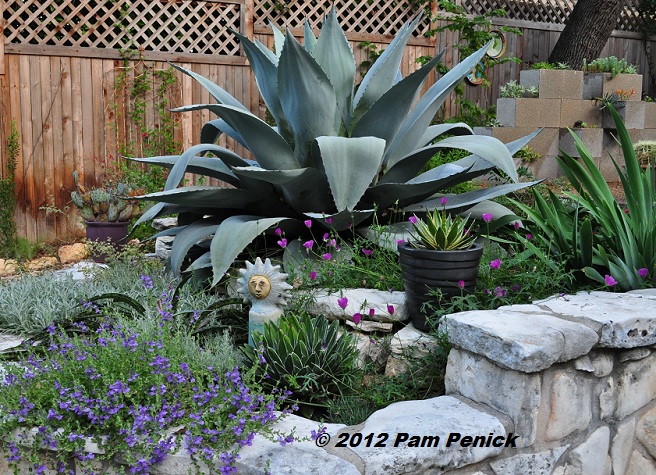
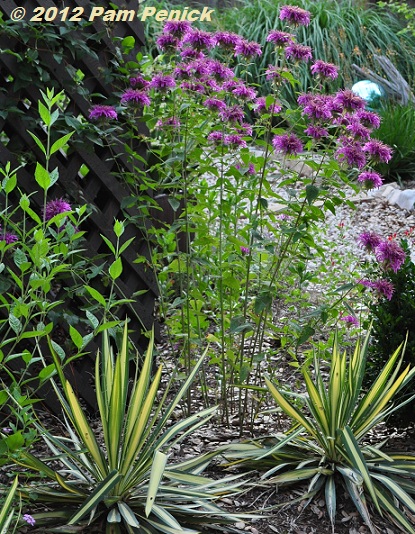
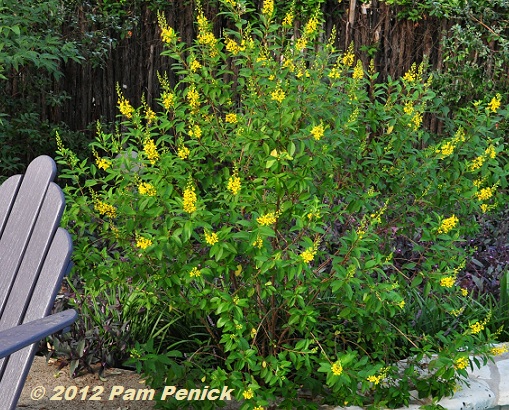
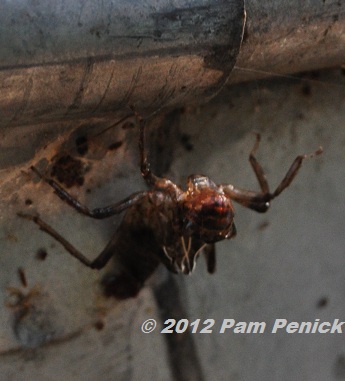
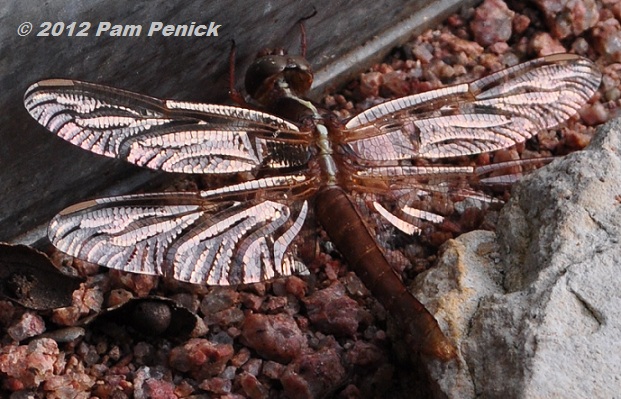
Hi Pam,
It all looks wonderful. I just bought Peter’s Purple Monarda after seeing yours. I now know of 3 Monardas that can grow in Houston. It’s a great native for cottage gardens and gravel gardens. I’m so excited about your neighbors. I have two new neighbors a few blocks over that have gardens rather than turf. I’m getting my courage up to knock on their front door and introduce myself. Congrats on the dragonfly. Mine are late this year.
David/:0)
What are your other two monardas, David? And how exciting about the neighborhood changes! —Pam
Yikes…when you said the temps came “down” into the 90’s, it pretty much cemented that you (and your plants) are far tougher than I, Pam! So glad to hear your neighbors are getting into the act and doing something interesting…woohoo! I love ‘Peter’s Purple’, I sort of wish I could tear out my ‘Raspberry Wine’ and replace it with that Monarda…the color seems so much subtler…is it true that it’s pretty Mildew-resistant? So cool about the dragonfly…I’ve only seen one here in the garden…I need some sort of “pond” I guess 😉
Ha—well, down into the lower 90s. I don’t think we’ve hit 100 yet this summer. But we will. Last summer we endured 3 months of 100+ temps, and it tried our Texas toughness. I’m hoping for only the annual average of about 13 days of 100+ this summer. But then we have sunny, beautiful days October through May, when you Portlanders endure the clouds and wet, so perhaps it all evens out. 🙂 As for the monarda, yes, ‘Peter’s Purple’ has been resistant to powdery mildew in my garden. —Pam
I love joining you for quiet moments in your garden…spying that dragonfly is a sweet thought I would carry with me for days! Lucky you. How much sun is your thryallis getting, Pam? A few have posted recently that they like it in part-shade. I’ve always thought of it as a sun lover. I’d like to add it’s cheerful yellow somewhere.
Hi, Cat. My thryallis gets only a little early afternoon sun, but mostly it’s in dappled shade. And it does just fine! —Pam
Holy Guacamole! Your agave ovatifolia almost stopped my heart – actually, its entirely possible it did. That is incredible!
I really love that agave, Louis. I keep expecting that each summer will be its last, and I watch anxiously for a bloom spike. It’s getting to that age. —Pam
I’m basking in the borrowed warmth of your post as we face another dreary, drissely day here in Portland. You really captured a “moment” with that last shot.
Thanks, Ricki. I hope you get some sunshine soon! —Pam
What a lovely dragonfly. I have seen more copper dragonflies this spring than I ever remember. Your capture of the wings is magnificent. Pam, I planted a Peter’s Purple Monarda last year and it made it through the drought. It has had a spectacular showing of blossom (8a)Dallas-Fort Worth. I planted ‘Jacob Cline’ (Monarda didyma) this spring. It is red. I will let you know how it does. Peter’s Purple is a real winner though. Always enjoy seeing your garden.
‘Peter’s Purple’ monarda performed beautifully in our horrible summer last year too. Now I’m seeing it pop up all over Austin. I’m glad to know about ‘Jacob Cline’ and would love to hear how it does for you. —Pam
I like the use of your drought resistant plants, and I have to remember that I live in the humid hot south. Some of those succulents would work, others, not. Your garden plantings are beautiful…I will admire from afar.
It’s pretty sultry in Austin in the summer too, Janet, although you may get more rain than we do. Our average annual rainfall is 32 inches, although during last year’s drought we received just half of that. Assuming your winter temps are not too cold—and some agaves can take cold, so choose carefully—the key is excellent drainage. This vignette is planted in a raised bed, with lots of decomposed granite mixed into already sharp-draining soil. I do irrigate, and we do get winter rain. The raised bed and good drainage keeps it from standing around the roots of these dry-loving plants, and they do just fine. Tony Avent at Plant Delights in Raleigh achieves good drainage in his hot, humid climate with gravelly, bermed beds. —Pam
That copper dragonfly is gorgeous — and so is your garden. Soo…how long do ‘Whale’s Tongue’ agaves generally live (and how old was yours when you moved it)? Jack wants to move ours, but I suspect it’s not worth the Herculean effort; they don’t last forever, and the move might trigger an early demise.
An agave’s life span is influenced by your garden’s conditions. If you irrigate (as I do), your agave has probably grown faster than it would in the wild, and it will also have a shorter life span. I planted mine from a one-gallon pot in 2006 or 2007, so it’s about 6 years old. I moved Moby to my current garden 3-1/2 years ago with no ill effects that I’ve noticed. Agaves actually don’t mind being transplanted, and they can be bare-rooted without harm. So unless yours is particularly large you can probably move it without triggering its bloom spike. Without blood loss? That’s debatable. —Pam
Your “Moby” is gorgeous! Mine is tiny right now, but if its half as pretty in 6 years as yours is now, I’ll be happy. Do you find that the Monardas need a lot of water to stay happy? I’ve been wanting to try one, but worry they need too much water…
Hi, Renee. This monarda doesn’t seem to require an excessive amount of water. I irrigate once a week in the summer (in mostly sun with temps in the 90s) if it hasn’t rained in a while, and it’s been growing and blooming with abandon. —Pam
Your garden is beautiful. Your monarda is impressive. I have started trying to learn about drought resistant plants and am curious to see how your neighbors gardens pan out.
Thanks, Ruth. I wish I had a “before” picture of my neighbor’s overgrown foundation bed in order to contrast it with the new plants she’s in the process of planting. What a welcome change, and she’s loving the openness of her space and the way the architecture of her house is revealed after years of being hidden behind overgrown shrubs. —Pam
Hi
I stumbled onto your blog while searching information on Thryallis. Your gardens are lovely! I am in zone 8 as well. I recently purchased a thryallis. I want to try starting some more from seeds. I read plant them when green? I was wondering if you could tell me does that mean literally its green on the plant still? I have figured out the 3 lobed pods are the seeds, or so I believe from my reading. :O).
I also recently purchased some Texas Lilacs,(Vitex) those guys love our sun and heat! I plan to start more of those as well!
Hi, Texan. I wish I could help, but I’ve never grown thryallis from seed. I wish you luck, as they are very beautiful! —Pam
PS
I am in East Texas :O)